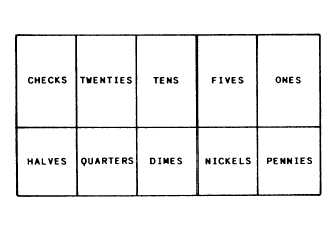| |
identification card and verify the signature to
make sure it is the same as that on the traveler’s
check.
PUTTING MONEY IN THE
REGISTER
Once you have signed for your change fund
as discussed earlier, you will have to arrange the
cash from the change fund in your cash tray. It
may seem strange, but the number of cash
handling errors you make may be related to how
you arrange your money in the cash tray. After
you count your money, arrange it in the cash
register carefully as shown in figure 2-5. If your
cash register has less than five compartments,
place any checks you receive during the day under
the cash- tray in the cash drawer. Make sure all
bills are placed in their respective compartments,
facing up in the same direction. Make sure while
putting the bills in the tray that they do not stick
together. If the bills are new, it is a good practice
to turn the corner down on each bill to prevent
giving two instead of one for change. Large bills
such as $50 or $100 should always be placed under
the money tray.
Keep coins in their own
compartments, with pennies on the right, then
nickels, dimes, and quarters. Half dollars should
be kept together in one compartment next to the
quarters.
Before ringing up your first sale of the day
you should make certain the area around the cash
register is clear.
Do not clutter the area
surrounding the cash register with signs, notes,
or other items. The sales window should be clear
so the customer can see the amount of sale being
registered.
Figure 2-5.—Arranging money in the register.
2-14
TAKING THE CUSTOMER’S
MONEY
Most errors happen during the exchange of
money between the customer and the operator of
the store. Before you actually take the money, ring
up each item the customer is purchasing separately
on the cash register. Do not try to add the total
price of more than one item in your head. The
cash register is designed to do this for you.
Complete each transaction before thinking about
starting another one. This will prevent confusing
yourself and the customer and will avoid
any shortages or overages in the cash re-
gister. Apologize to the customer who must
wait. The better you manage your customers,
the fewer errors you will make in handling
money.
Count the money as you receive it from the
customer for each sale. Repeat out loud the
amount of money handed to you, as well as the
amount of the sale. By doing this for every sales
transaction, you avoid the chance of becoming
confused if the customer should claim that a larger
bill was given to you. For example, as the
customer hands you this money, you should say,
“Thank you, that will be $4.35 out of $5.” Leave
the amount of money received on the change plate
until you count the change from the till. If
someone interrupts you or you forget, you will
have the exact amount received in front of you
just below the row of keys on the register. You
will not have any doubt or mistakes on the
amount. Count the change twice, first as you take
it from the till and second as you give it to the
customer. Start counting your change from the
amount rung up until you build up to the amount
received. For example, if you have to ring up
$4.35 out of $5, you would pickup a nickel and
a dime from your till and count aloud, “Four
forty, four fifty,” and then pick up two quarters
and count aloud,
“Four seventy-five, five
dollars.” Repeat in the same way as you count
the change into the customer’s hand. If you or
the customer finds an error in your count, take
back all change from the customer. Make your
corrections, and then count the change correctly
into the customer’s hand. Now remove the money
from the change plate and put it in the cash
drawer. Be sure to close the cash drawer after
every transaction; never work out of an open cash
drawer. If your cash register provides a receipt,
tear the receipt off and give it to the customer.
Always remember to look at your first receipt of
|

